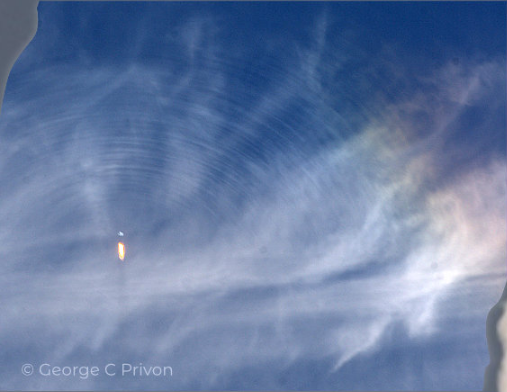Mars Perseverence Pond Ripples, Interference
Mars Perseverance Pond Ripples: A Spectacular Phenomenon Explained
The mesmerizing sight of the Atlas V rocket lifting the Perseverance rover towards Mars on July 30 was accompanied by a rare and colorful glow at its tip. Captured by photographer Alex Polimeni, the image reveals a phenomenon that initially appears to be a corona but holds unique characteristics that set it apart. In this article, we delve deeper into this captivating event, exploring the science behind it and unraveling the mysteries of Mars Perseverance pond ripples and interference.
As we examine the photograph closely, we notice that the sun was positioned low in the east, casting a shadow from the rocket towards the right. This positioning rules out the possibility of the glow being a corona, as coronae typically encircle the sun or other bright light sources. Additionally, the color sequence and oval shape of the rings do not align with the characteristics of a corona. So, what could be causing this enchanting display?
The key to understanding this phenomenon lies in the shadow itself. Shadows created through the air require specific elements to be visible, such as dust, aerosols, or water droplets. In this case, it is likely that a localized cloud of water droplets surrounded the craft or existed in a layer just beneath it. The absence of a strong shadow cast by the exhaust plume indicates that the air was not generally hazy with water droplets.
The formation of water droplets can be attributed to the shock waves radiating outward as the craft went supersonic. These shock waves cause the air to rarefy and cool, leading to the condensation of water vapor into tiny droplets. Since these droplets are formed simultaneously, they tend to have similar sizes, making them ideal for diffracting light and producing colorful iridescence. The resulting colors appear in rings resembling pond ripples caused by a stone thrown into still water. Notably, thicker condensation from the shock waves can be observed surrounding the rocket's tip, adding to the spectacle.
However, the impact of rocket shock waves extends beyond the creation of pond ripples. These powerful shock waves have the ability to shake ice crystals and even disrupt the formation of sundogs. Sundogs, also known as parhelia, are bright spots that appear on either side of the sun, often accompanied by a halo. The destructive nature of rocket shock waves on these beautiful atmospheric phenomena highlights their immense power and influence.
In conclusion, the captivating display captured in the photograph of the Mars Perseverance launch can be attributed to a combination of factors. The formation of water droplets due to shock waves, their similar sizes, and their ability to diffract light create the mesmerizing rings reminiscent of pond ripples. The presence of thicker condensation around the rocket's tip adds to the visual spectacle. This phenomenon serves as a reminder of the intricate interplay between atmospheric conditions and the awe-inspiring phenomena that can occur in our skies.

Pond ripples
A rare coloured glow lights the Atlas V rocket tip as it lifts Perseverance
rover towards Mars on July 30.
Photo by Alex Polimeni (site, Twitter) photographer at Spaceflight Now and
veteran of over 70 launches.
The glow was transient as the rocket went supersonic. At first sight it resembles a corona. But, coronae only circle the sun or other bright lights. At launch the sun was low in the east to the lower left of the image as evidenced by the rocket's shadow stabbing outwards to the
right. The colour sequence is not right for a corona and the rings are oval. A glory then? Glories are always opposite the sun.
The shadow is a clue. Shadows through the air need dust, aerosol....or water drops to be seen. A local cloud of droplets surrounds the craft or they are in a layer just beneath it. The air was not more generally hazy with water drops because the exhaust plume does not cast any strong shadow.
Shock waves radiating outwards as the craft went supersonic produced the droplets. Air rarefies and cools behind shock waves condensing water vapour into tiny droplets. These drops, formed all at the same time have similar sizes. They are ideal for diffracting light to produce colourful iridescence. The colours are in rings like pond ripples from a tossed stone the 'stone' was the transonic rocket. Thicker condensation from shock waves surrounds the rocket's tip.
Rocket shock waves do more - they even shake ice crystals and destroy sundogs!

Note: this article has been automatically converted from the old site and may not appear as intended. You can find the original article here.
Reference Atmospheric Optics
If you use any of the definitions, information, or data presented on Atmospheric Optics, please copy the link or reference below to properly credit us as the reference source. Thank you!
-
<a href="https://atoptics.co.uk/blog/mars-perseverence-pond-ripples-interference/">Mars Perseverence Pond Ripples, Interference</a>
-
"Mars Perseverence Pond Ripples, Interference". Atmospheric Optics. Accessed on November 26, 2024. https://atoptics.co.uk/blog/mars-perseverence-pond-ripples-interference/.
-
"Mars Perseverence Pond Ripples, Interference". Atmospheric Optics, https://atoptics.co.uk/blog/mars-perseverence-pond-ripples-interference/. Accessed 26 November, 2024
-
Mars Perseverence Pond Ripples, Interference. Atmospheric Optics. Retrieved from https://atoptics.co.uk/blog/mars-perseverence-pond-ripples-interference/.